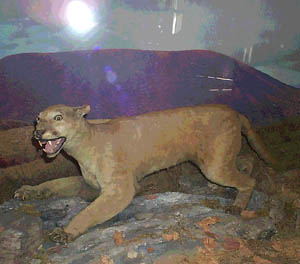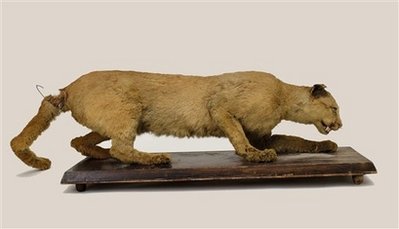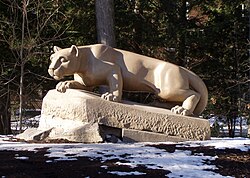Nittany Lions
Posted by: Loren Coleman on November 12th, 2011
If you live under a rock or are outside the influence of American media manias, you may not be aware of the fact that there is a major sexual abuse scandal occurring at Penn State and that today, Saturday, November 12th, the “Nittany Lions” football team members play their last home game of the season at Penn State.
The details of the scandal incidents are horrific. The Jerry Sandusky child sexual abuse scandal involves allegations made in 2011 against former Pennsylvania State University football assistant coach Jerry Sandusky and allegations of a university cover-up of those incidents. Sandusky, a longtime defensive coordinator under head coach Joe Paterno, retired in 1999 but retained access to Penn State’s athletic facilities. A 2011 grand jury investigation reported that Mike McQueary, then a graduate assistant, told Paterno in 2002 that he had seen Sandusky performing a sex act on a 10-year-old boy in Penn State football’s shower facilities. Paterno then reported the allegations to Penn State athletic director Tim Curley. In November 2011, Sandusky was arrested on 40 counts of molesting eight young boys over a 15-year period.
In addition, Curley and university Senior Vice President Gary Schultz resigned after being charged with failing to report the incident to police and lying to a grand jury regarding what they knew about the incident. Paterno and University President Graham Spanier were not charged, but both received criticism for their handling of the allegations. On November 9, Paterno announced he would retire at the end of the season, but hours later, he and Spanier were formally removed from their positions by the Penn State Board of Trustees.
If you wish to read more, see here or watch any current television broadcast on any sports or news channel. If you wish to see how this scandal actually has now been dated back to, at least, 1995, see here. Also, regarding news that the victims were mostly young African-American males, for insights about that part of the story which has been ignored by the mainstrem media, see here.
Having worked as a psychiatric social worker, in the child protective and child welfare systems, I am outraged by these events. But hopefully, good will issue forth from these news stories in alerting people to how often such incidents do occur, and how we all need to protect our and other children from such predators.
Cryptozoologically, because the phrase “Nittany Lions” is being used so frequently during this scandal, I wanted to tie an awareness of this topic to the alleged origins of why the school picked this name for their mascot. For those insensitive “Skeptics” who don’t appear to appreciate my interest in topics that are on the minds of the general public and who wish to criticize my posting of this item, lamely saying things like I wish to get “hits,” please save your feeble words. I have a long history of social service work in this arena. I actually think to not speak up about this, no matter the forum, is to continue the years of silence that is a problem with child assaults. We all need to be aware of such molestations, and if this venue can make even one more person (who visits here wishing to read about strange animals and cryptids) alert to this dangerous phenomena and gets them to explore what to do about it, all the better.
So, on to the “Nittany Lions”….
A modern urban legend was reinforced via an article in the Philadephia Inquirer of January 24, 2006. The news item was about three new mountain lion cubs from South Dakota being placed at the Philadelphia Zoo. The story was the source of the supposed alleged origin of “Nittany Lion” being due to the last puma killed on the mountain named Nittany (at the end of Nittany Valley). What do we really know about this tale?

Is this the actual origin of the “Nittany Lion,” the last mountain lion killed in Pennsylvania?
First, why “Nittany”? “Nittany” was around before Penn State, but it’s certainly has been used by the school (and half of the local businesses within 20 miles) for years. What is the etymology of the term?
The origins of “Nittany” are a bit obscure, but most likely the word comes from a Native American term meaning, “single mountain.” Since a number of Algonquian-speaking tribes inhabited central Pennsylvania, the term can’t be traced to one single group. The description applied to the mountain that separates what is today Penns Valley and Nittany Valley, with its western end overlooking the community of State College and Penn State’s University Park campus. The first colonial settlers in the 1700s adopted this term, or a variation of it, in formally naming Nittany Mountain (see William Ames’ famed photograph of this location, here).
Thus by the time Penn State admitted its first students in 1859, the word “Nittany” was already in use. Following the emergence of the Nittany Lion mascot in the early 1900s, Nittany gained even more public prominence. Today, the word helps to define a host of places, services, and other entities in the Nittany Valley.

This is said to be the last Eastern cougar to have existed in Pennsylvania; it was killed in Pennsylvania in 1874 by Thomas Anson. The felid was formerly part of the collection of Henry Shoemaker. Photo: State Museum of Pennsylvania, Pennsylvania Historical and Museum Commission, 2006.
The Nittany Lion is the mascot of the Pennsylvania State University in University Park, Pennsylvania, USA and its athletic teams. It refers to the mountain lions that once roamed near the school, and to Mount Nittany, a local landmark. There is also a fight song played during sporting events on campus entitled “The Nittany Lion.”
The Nittany Lion mascot pumps up the crowd at the 2005 football game versus Cincinnati at Beaver Stadium.
The mascot was the creation of Penn State senior H. D. “Joe” Mason in 1907. While on a 1904 trip to Princeton University, Mason had been embarrassed that Penn State did not have a mascot. Mason did not let that deter him: he fabricated the Nittany Lion on the spot and proclaimed that it would easily defeat the Princeton Bengal tiger. The Lion’s primary means of attack against the Tiger would be its strong right arm, capable of slaying any foes (this is now traditionally exemplified through one-armed push-ups after the team scores a touchdown). Upon returning to campus, he set about making his invention a reality. In 1907, he wrote in the student publication The Lemon:
Every college the world over of any consequence has a college emblem of some kind—all but The Pennsylvania State College . . .. Why not select for ours the king of beasts—the Lion!! Dignified, courageous, magnificent, the Lion allegorically represents all that our College Spirit should be, so why not ‘the Nittany Mountain Lion’? Why cannot State have a kingly, all-conquering Lion as the eternal sentinel?
(These words later inspired the fight song known as “The Nittany Lion”, which begins “Every college has a legend…”.)
Mountain lions had roamed on nearby Mount Nittany until the 1880s. The origin of the name “Mount Nittany” is obscure, the most commonly accepted explanation being that it is derived of Native American words (loosely pronounced as “neet-a-nee”) named after the cougars that roamed the mountain or “single mountain” – a protective barrier against the elements.
The name was readily accepted without a vote of the student body. In 1907, the first tangible lion symbols appeared with the placing of two alabaster African lion statues, left over from the Pennsylvania exhibit at the 1904 Louisiana Purchase Exposition, atop the columns at the main campus entrance on College and Allen streets. They were affectionately dubbed by the student body as “Pa” and “Ma.” In the 1920s, a pair of stuffed mountain lions was placed in the Recreation Building to watch over athletic events. One of these original lions is now located in Pattee Library on the Penn State campus. About that same time, the tradition was established of having a student dressed in furry-lion outfits appear at football games.
The Lion Shrine
During the 1940s, seeking a place to hold pep rallies and victory celebrations, students launched a campaign for a lion shrine. As its gift to the university, the Class of 1940 voted to give the sum of $5,430 to pay for the construction of such a shrine, which was to be constructed between the Recreation Building and Beaver Stadium, with the lion framed against a natural setting of trees, grass, and shrubs. The sculptor Heinz Warnecke was retained to carve the lion at the site from a thirteen-ton block of limestone. The sculpture was formally unveiled on October 24, 1942. The shrine has come to be one of the most visited and photographed sites, not just on campus, but also in the entire Commonwealth of Pennsylvania.
“Guarding the Shrine” is a Homecoming weekend tradition at Penn State, started in 1966 when Sue Paterno (wife of football coach Joe Paterno) and a friend covered the lion in orange latex-based paint as a way of stoking interest in that year’s game against PSU rival Syracuse. While that paint washed off easily, a later dousing by actual Syracuse fans with oil-based paint proved much harder to remove, requiring sand blasting. The shrine is guarded for the duration of Homecoming weekend by Penn State’s ROTC detachment, Blue Band, alumni, current students, faculty, and by the Lion Ambassadors. The latter group brings food, music, games, and (starting in 2004) an event called “Last Guard Standing”, attracting students from all over campus. Originally, the guard was manned by freshmen. In another football weekend incident [date?] the Lion Shrine was vandalized when a blunt object was used to break off the statues right ear. The original sculptor remained alive at the time and, with some difficulty, was able to match the stone and repair the damaged ear. This incident led to the site being guarded during home football games.
Actually, of course, in 1904, Joe Mason appears to have based the invention of the “Nittany Lion” on the African lion, not the mountain lions of Pennsylvania, but then, the urban legend around Penn State’s “Lions” has a huge p.r. machine behind it, even today.
About Loren Coleman
Loren Coleman is one of the world’s leading cryptozoologists, some say “the” leading living cryptozoologist. Certainly, he is acknowledged as the current living American researcher and writer who has most popularized cryptozoology in the late 20th and early 21st centuries.
Starting his fieldwork and investigations in 1960, after traveling and trekking extensively in pursuit of cryptozoological mysteries, Coleman began writing to share his experiences in 1969. An honorary member of Ivan T. Sanderson’s Society for the Investigation of the Unexplained in the 1970s, Coleman has been bestowed with similar honorary memberships of the North Idaho College Cryptozoology Club in 1983, and in subsequent years, that of the British Columbia Scientific Cryptozoology Club, CryptoSafari International, and other international organizations. He was also a Life Member and Benefactor of the International Society of Cryptozoology (now-defunct).
Loren Coleman’s daily blog, as a member of the Cryptomundo Team, served as an ongoing avenue of communication for the ever-growing body of cryptozoo news from 2005 through 2013. He returned as an infrequent contributor beginning Halloween week of 2015.
Coleman is the founder in 2003, and current director of the International Cryptozoology Museum in Portland, Maine.












It has been said by those who observe it regularly, and having seen it on numerous occasions myself I would agree, that the outline of Nittany Mountain resembles somewhat a crouched feline, such as a mountain lion. I suppose it also resembes a crouched dachshund, or a naked lady under a blanket, neither of which would be as acceptible as a team mascot, however. cheers.
See William Ames’ famed photograph of Nittany Mountain, here.
Loren,
I graduated PSU in 1987; I grew up just a few miles from Nittany Mountain (Houserville) and my family on both sides has been in that valley since the late 1780s.
My grandfather, Steward Musser, was born a few miles away (Aaronsburg) in 1901. When I was a boy in the early 1970s I read a book about Bigfoot and I asked him “Pappy, did you ever see anything unexplained in the woods growing up?” I was beside myself with anticipation, hoping that he might have seen something prehistoric, but then he said “I was walking back to the house one evening at dusk when I was a boy, and all of a sudden I saw something out of the corner of my eye. I turned and saw a mountain lion on our big fence staring at me, and I ran into the house as fast as I could and didn’t look behind til I slammed the door. When I looked out the window he was gone.” At the time, I had no idea that mountain lions were supposed to have been extinct in PA by the late 1800s.
About 25 miles from Aaronsburg (and about 40 miles from Penn State) is Bald Eagle Mountain. In one of your books you mentioned the “Indian fighter” (was his name Shoemaker? I’m drawing a blank at the moment) who possibly killed an African cave lion and its mate there back in the 1780s/1790s. When spring comes I’ll try to get up that way and see if the cave that Shoemaker crawled into is still there.
Whoops! I meant to write “American cave lion”.
THANK YOU for your comments in defense of children everywhere. If it always came out into the open, and there were no secrets, Child abuse would be almost non-existent. Instead, some researchers estimate that as many as a third of children in the US have suffered some form of abuse, and as many as 1 in 6 women are raped at some point in their lives. These are not single events… abuse has lifelong effects on survivors. Kudos to you and to each person who chooses NOT to ignore abuse they see or are told about. Some people may feel uncomfortable at the time reporting something a child has said, but if they save one child from lifelong suffering (or death), they have made the world a better place.
The story of the Nittany Lions’ history is interesting, and I do believe mountain lions still roam the northeast. My neighbor in Western Maine maintains a large tree farm and has seen and heard a lion deep in the woods there several times. In this age of people carrying cell phones, I’m reasonably certain we’ll get photographic proof before long.
Wait a minute, hugesummers, did you really mean American Cave Lion? As in, Panthera lwo atrox? Because, the last time I checked, Panthera leo atrox had been extinct, since the end of the Pleistocene Epoch. Do you mean that they might possibly still be alive, today? That is very interesting! :D!
Yes sir – if I remember correctly, Mr. Coleman recounted the Bald Eagle Mountain (PA) case, and one in early California, to raise the possibility that American cave lions existed into historical times.